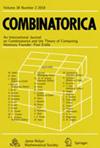改进的Chen-Chvátal猜想的下界
IF 1
2区 数学
Q1 MATHEMATICS
引用次数: 0
摘要
我们证明了在任何没有直线包含所有点的度规空间中,至少存在\(\Omega (n^{2/3})\)条直线。这改进了前面一般度量空间中行数的\(\Omega (\sqrt{n})\)下界,也改进了前面由连通图生成的度量空间中行数的\(\Omega (n^{4/7})\)下界。本文章由计算机程序翻译,如有差异,请以英文原文为准。
Improved Lower Bound Towards Chen–Chvátal Conjecture
We prove that in every metric space where no line contains all the points, there are at least \(\Omega (n^{2/3})\) lines. This improves the previous \(\Omega (\sqrt{n})\) lower bound on the number of lines in general metric space, and also improves the previous \(\Omega (n^{4/7})\) lower bound on the number of lines in metric spaces generated by connected graphs.
求助全文
通过发布文献求助,成功后即可免费获取论文全文。
去求助
来源期刊

Combinatorica
数学-数学
CiteScore
1.90
自引率
0.00%
发文量
45
审稿时长
>12 weeks
期刊介绍:
COMBINATORICA publishes research papers in English in a variety of areas of combinatorics and the theory of computing, with particular emphasis on general techniques and unifying principles. Typical but not exclusive topics covered by COMBINATORICA are
- Combinatorial structures (graphs, hypergraphs, matroids, designs, permutation groups).
- Combinatorial optimization.
- Combinatorial aspects of geometry and number theory.
- Algorithms in combinatorics and related fields.
- Computational complexity theory.
- Randomization and explicit construction in combinatorics and algorithms.
 求助内容:
求助内容: 应助结果提醒方式:
应助结果提醒方式:


